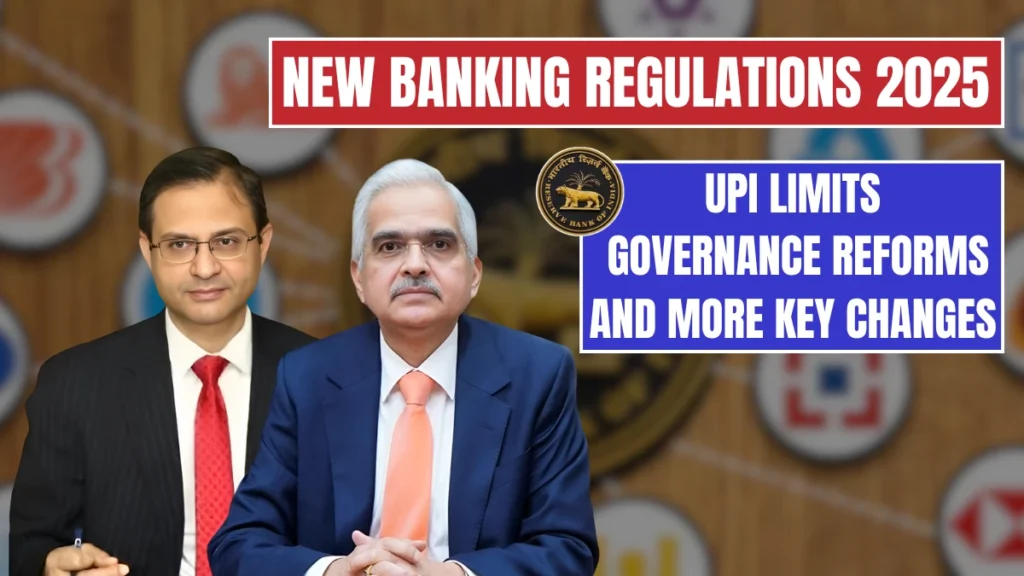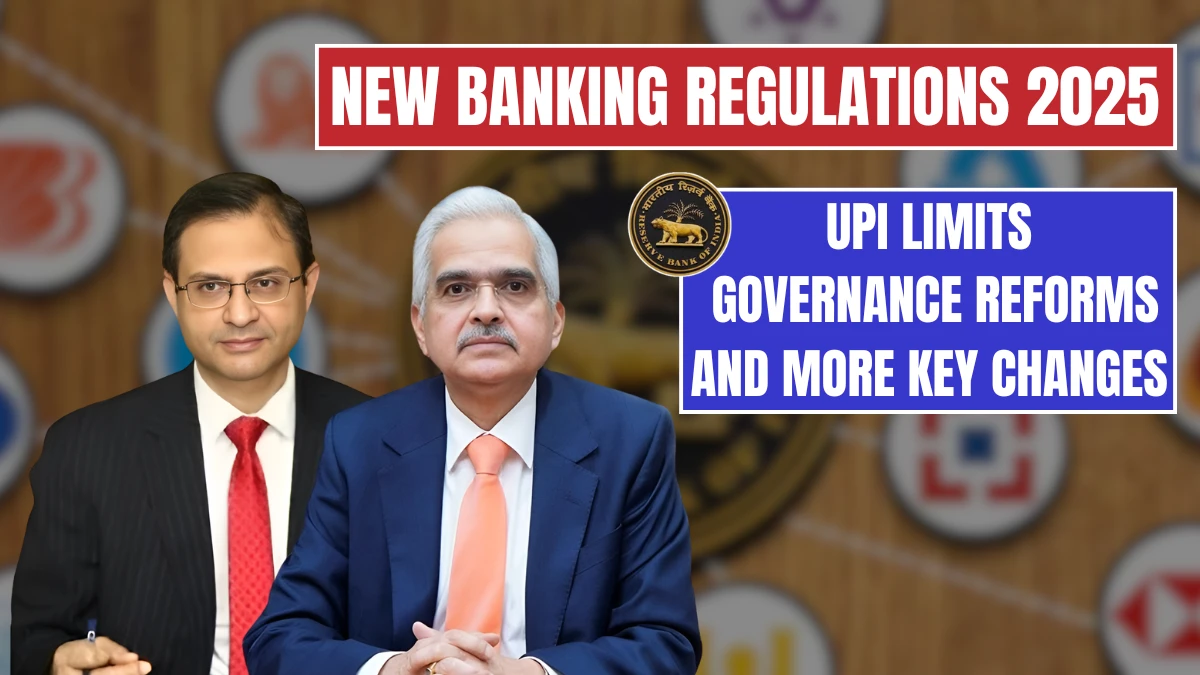New Banking Regulations 2025 – The banking landscape is set to undergo a major transformation in 2025, as new regulations are introduced to improve the functioning of financial institutions, safeguard consumers, and enhance overall financial stability. Among the changes, limits on UPI transactions, governance reforms in banks, and stronger consumer protection laws stand out as significant developments.
These new regulations will not only reshape the way financial institutions operate but also affect how customers interact with banking services. In this post, we will dive deep into the key changes and what they mean for the future of banking.

UPI Transaction Limits: A Step Toward Responsible Digital Payments
Unified Payments Interface (UPI) has emerged as one of the most popular and convenient ways to make digital payments in India. However, the explosive growth in UPI transactions has raised concerns about security and sustainability. To address these issues, the new banking regulations introduced in 2025 set transaction limits for UPI, capping the number of daily transactions individuals and businesses can make.
The decision to impose these limits is driven by the need to maintain a secure, efficient, and stable digital payment ecosystem. While the introduction of such caps may seem restrictive at first, it is expected to reduce the likelihood of fraud and misuse. However, there is a silver lining verified users who complete a robust Know Your Customer (KYC) process can access higher transaction limits. This ensures that legitimate users still enjoy the convenience of higher transaction volumes while preventing potential misuse by those who haven’t been properly verified.
Additionally, the cap is aimed at preventing overload on the UPI infrastructure, ensuring that the system continues to operate smoothly and can scale in the future without major hiccups. These changes are expected to balance the need for security with the desire for user convenience, helping to protect users from fraud while keeping the payment ecosystem sustainable.
Governance Reforms: Improving Transparency and Accountability
One of the most crucial aspects of the new banking regulations is a set of governance reforms aimed at increasing transparency and accountability within banks. With growing concerns over conflicts of interest and the need for better decision-making frameworks, the government has mandated several structural changes that will affect the way banks are run.
A key reform is the separation of roles between the CEO and the Chairman of the Board in banks. Previously, many institutions had a single individual occupying both positions, which led to potential conflicts of interest. The new regulations require these roles to be separated to ensure that decision-making remains independent and objective. This is a significant move aimed at enhancing governance structures and reducing the chances of bias or undue influence in strategic decisions.
In addition, banks will now be required to establish independent risk management committees that report directly to the board of directors. These committees will be tasked with identifying and managing various financial risks, such as credit, liquidity, and operational risks. With a greater focus on risk management, these reforms aim to make banks more resilient to financial crises and reduce the chances of systemic failure.
Another important governance reform is the introduction of stricter reporting requirements. Banks must now provide more detailed disclosures about their operations, including risk management activities, compliance levels, and financial performance. This move is intended to foster greater trust among stakeholders, including customers, investors, and regulators, by providing clearer insights into a bank’s health and decision-making process.
Strengthened Consumer Protection Laws: Safeguarding the Public
With the rise of digital banking and online transactions, consumer protection has become an increasingly important issue. The new banking regulations in 2025 introduce several measures to enhance the protection of consumers in the rapidly evolving financial landscape.
One of the most significant changes is the mandatory establishment of a digital grievance redressal mechanism for all banks. This mechanism will enable customers to easily lodge complaints related to digital banking services, such as transaction errors or issues with mobile banking apps. Banks will be required to resolve these complaints within a set timeframe, ensuring that customers can quickly address any issues they encounter.
The regulations also mandate that banks implement an insurance coverage plan for digital transactions. This means that customers will be financially protected in case of fraudulent or unauthorized transactions. If a fraud is detected, the bank will be obligated to reimburse the affected customer within a specific period, thus enhancing trust in the security of digital banking systems.
Additionally, the regulations require banks to make their fee structures more transparent, ensuring that customers are fully aware of any charges or penalties associated with their accounts and services. This level of transparency is intended to protect consumers from hidden fees and unexpected charges, which are often a source of frustration.
Financial Inclusion Initiatives: Making Banking Accessible to All
Another significant change brought about by the 2025 banking regulations is a strong push for financial inclusion. Despite the rapid growth of digital banking, millions of people, particularly in rural areas, still lack access to basic banking services. To address this gap, the new regulations introduce several initiatives aimed at expanding access to financial products and services.
One of the key measures is the encouragement of banks to establish more branches, ATMs, and digital kiosks in underserved regions. These efforts are designed to bring banking services closer to rural and remote populations, allowing them to open accounts, deposit money, and access other essential services without having to travel long distances.
The new regulations also require banks to offer low-cost, no-frills banking products targeted at low-income individuals. These accounts, which have minimal or zero maintenance fees, are designed to make banking more affordable for people in underserved communities. With a growing focus on financial inclusion, these initiatives aim to bring banking to the doorsteps of those who need it the most.
In addition to these efforts, the regulations encourage banks to provide microloans and micro-insurance products. These small-scale financial products can help individuals and small businesses in rural areas access the capital they need to grow and thrive. By providing affordable credit and insurance, the banking sector can help empower underserved communities and contribute to economic development.
Strengthening Cybersecurity: Safeguarding Digital Transactions
As digital banking continues to grow, the risk of cyberattacks and fraud has become an ever-present concern. To mitigate these risks, the new banking regulations include stringent cybersecurity measures to protect both customers and financial institutions from malicious actors.
A major requirement under the new rules is the implementation of multi-factor authentication (MFA) for all online and mobile banking transactions. MFA adds an extra layer of security by requiring users to provide more than just a password to authenticate their identity. This makes it significantly harder for cybercriminals to access accounts and conduct fraudulent transactions.
Banks are also required to adopt the latest encryption technologies to protect customer data and ensure that sensitive information, such as account details and transaction histories, remains secure. In addition, the regulations mandate that banks conduct regular cybersecurity audits to identify vulnerabilities and ensure compliance with industry standards.
Another important aspect of the new regulations is the creation of dedicated cybersecurity teams within banks. These teams will be responsible for monitoring cyber threats, responding to incidents, and ensuring that banks are prepared to handle any emerging risks.
Conclusion
The banking regulations of 2025 represent a major overhaul of the financial sector, with significant changes that impact everything from daily digital payments to governance structures within financial institutions. With a focus on improving security, enhancing transparency, and promoting financial inclusion, these regulations are designed to build a more resilient, equitable, and customer-friendly banking environment.
Although the changes may present challenges for both banks and consumers, the long-term benefits are expected to be substantial. By strengthening governance, protecting consumers, and fostering financial inclusion, the new regulations aim to create a banking system that is more transparent, secure, and accessible to all. As these changes take effect, banks will need to adapt quickly and innovate in order to meet the evolving needs of customers while complying with the new regulatory framework.
Disclaimer: The information in this post is for general informational purposes only and should not be construed as legal, financial, or professional advice. Please consult relevant experts for specific guidance on banking regulations.
